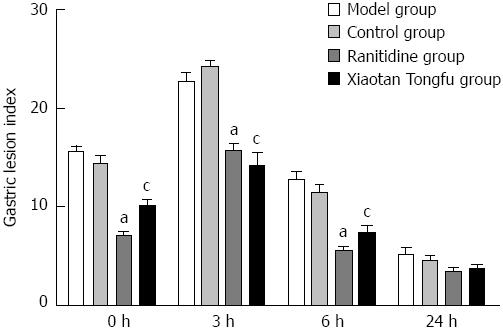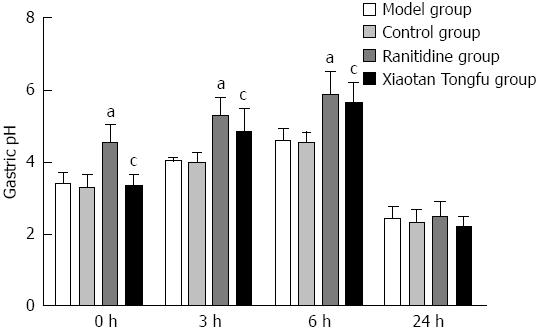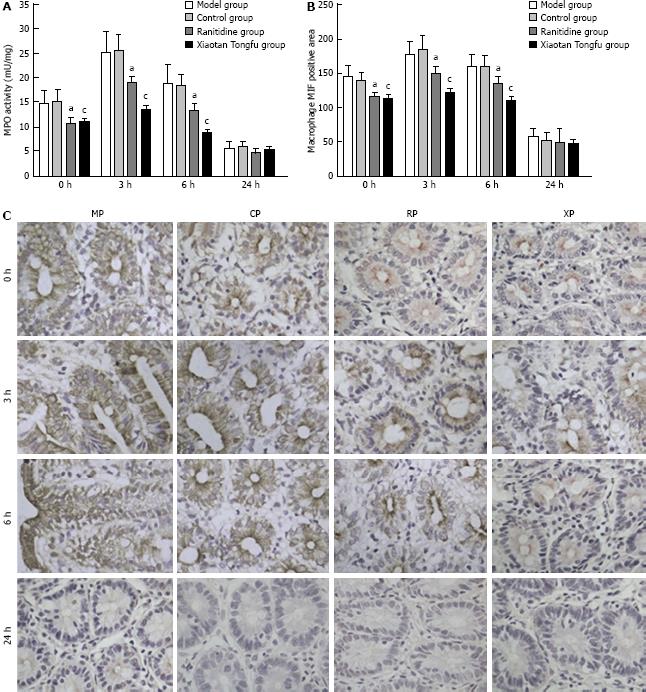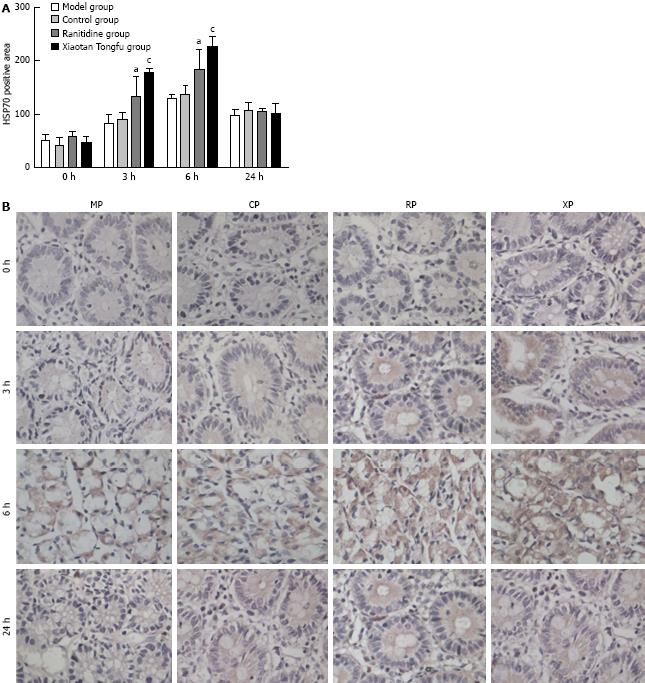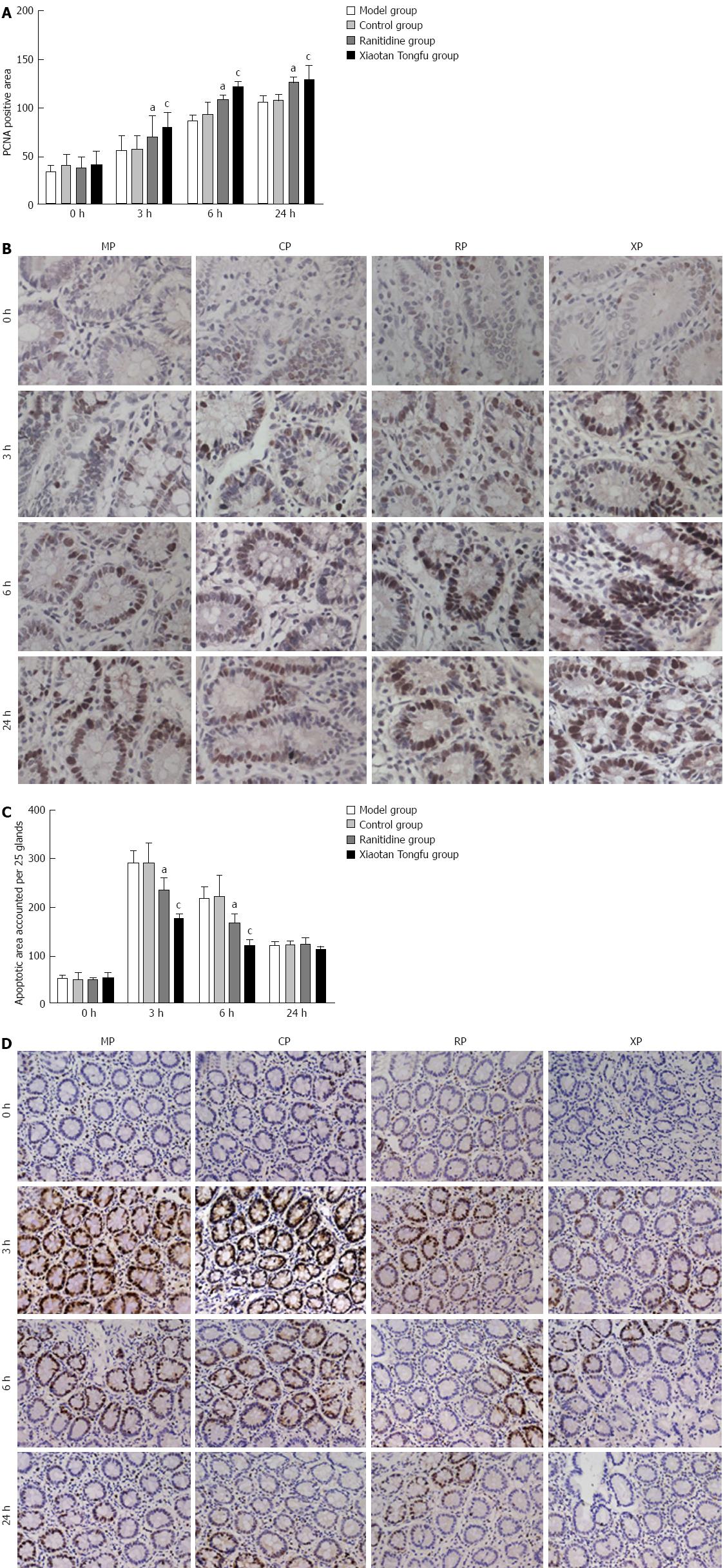Copyright
©2013 Baishideng Publishing Group Co.
World J Gastroenterol. Sep 7, 2013; 19(33): 5473-5484
Published online Sep 7, 2013. doi: 10.3748/wjg.v19.i33.5473
Published online Sep 7, 2013. doi: 10.3748/wjg.v19.i33.5473
Figure 1 Results of the gastric lesion index (n = 6 for each group).
At 0 h, ranitidine was demonstrated to be the most powerful agent in the inhibition of gastric lesions. The difference in the inhibition of gastric lesions between the ranitidine group and the Xiaotan Tongfu granule group was statistically significant (P < 0.05). However, at the subsequent time points, this difference vanished. aP < 0.05 vs the model group; cP < 0.05 vs the control group.
Figure 2 Results of gastric pH (n = 4 in each group).
At 0 h, ranitidine was demonstrated to be the most powerful agent in increasing the gastric pH, and the increase in the gastric pH was significantly different between the ranitidine group (RP group) and the Xiaotan Tongfu granule group (XP group) (P < 0.05). In addition, there were no significant differences regarding the increase in the gastric pH among the XP, the model group (MP group), the control group (CP group) (P > 0.05). At 3 h and 6 h after stress induction, there were no differences in the gastric pH between the RP and XP groups. aP < 0.05 vs the MP group; cP < 0.05 vs the CP group.
Figure 3 Results of the gastric emptying rate (n = 6, 2 rats were used as controls for each group).
At 0 h, the Xiaotan Tongfu granule group (XP group) was superior in elevating the gastric emptying rate (GER); however, no significant difference was detected between the ranitidine group (RP group) and the XP group at this point (P > 0.05). At 3, 6 and 24 h after stress induction, the GER in the XP group was sustained at a high value and was significantly different compared to the RP group (P < 0.05). aP < 0.05 vs the model group; cP < 0.05 vs the control group.
Figure 4 Measurement of myeloperoxidase activity and macrophage migration inhibitory factor (n = 6 for each group).
A, B: The variation of myeloperoxidase activity (MPO) activity and migration inhibitory factor (MIF) was similar. At 0 h, no significant difference was detected between the ranitidine group (RP group) and the Xiaotan Tongfu granule group (XP group) (P > 0.05). However, 3 and 6 h after stress induction, these two indexes were inhibited in the XP group, which was a statistically significant difference compared to the RP group (P < 0.05). aP < 0.05 vs the model group (MP group); cP < 0.05 vs the control group (CP group); C: The immunohistochemical staining results of MIF show that it was expressed in the cytoplasm of gastric epithelial cells and lamina propria cells. Original magnification × 400.
Figure 5 Immunohistochemical staining results for heat shock protein 70 (n = 6 for each group).
A: There was a statistically significant difference in the protein expression levels between the ranitidine group (RP group) and the Xiaotan Tongfu granule group (XP group) groups at 3 and 6 h at the exact site of initial ulceration (P < 0.05). aP < 0.05 vs the model group (MP group), cP < 0.05 vs the control group (CP group); B: Strong heat shock protein 70 (HSP70) immunoreactivity was observed in the gastric surface epithelium primarily in the nuclei, but protein was also observed in the cytoplasm. Original magnification × 400.
Figure 6 Measurement of cell proliferation and mucosal cell apoptosis (n = 6 for each group).
A: The cell proliferation was significantly different between the ranitidine (RP) and Xiaotan Tongfu granule (XP) groups (P < 0.05) at 3 and 6 h; B: Proliferating cell nuclear antigen (PCNA) immunoreactivity was observed in the gastric surface epithelium, and this staining was focused in the nucleus; C, D: Strongly apoptotic cells were observed in the nucleus of the gastric surface epithelium. Similar to the cell proliferation, the cell apoptosis was significantly different between the RP and XP groups at 3 and 6 h (P < 0.05). Original magnification × 400. aP < 0.05 vs the model group (MP group); cP < 0.05 vs the control group (CP group).
- Citation: Yan B, Shi J, Xiu LJ, Liu X, Zhou YQ, Feng SH, Lv C, Yuan XX, Zhang YC, Li YJ, Wei PK, Qin ZF. Xiaotan Tongfu granules contribute to the prevention of stress ulcers. World J Gastroenterol 2013; 19(33): 5473-5484
- URL: https://www.wjgnet.com/1007-9327/full/v19/i33/5473.htm
- DOI: https://dx.doi.org/10.3748/wjg.v19.i33.5473









